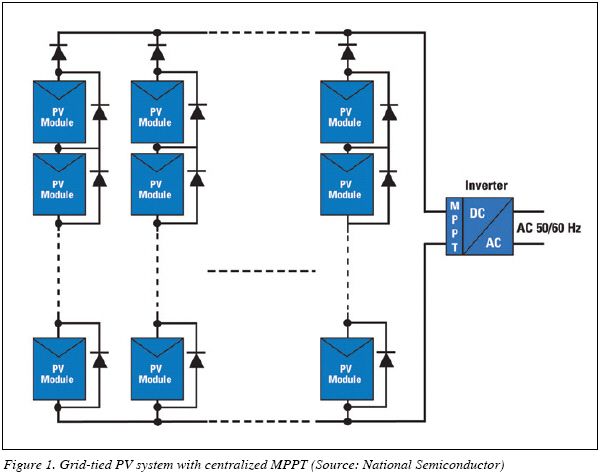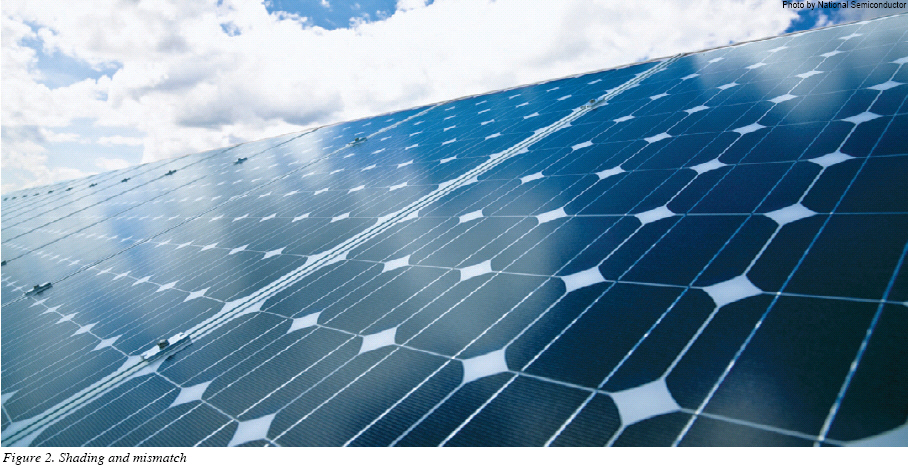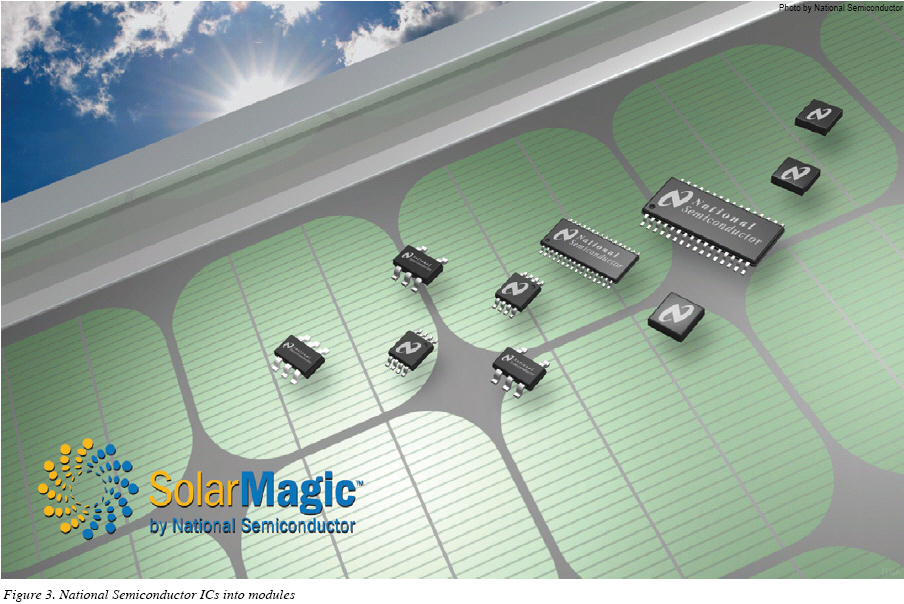By Leslie Bane, Kevin Kayser

Solar Photovoltaic (PV) energy, the next big frontier in energy generation, has been drawing big investors over the past 10 years as solar continues to deliver 30%+ year-on-year growth. The basics of solar PV started over 50 years ago, and it has remained largely unchanged technology wise since the beginning. As such, the current technology suite of modules and inverters does not seem to be meeting all of the financial needs and returns to drive the industry towards the widespread adoption necessary to create a sustainable industry without relying on government subsidies. With the advent of distributed electronics, ranging from DC-DC power optimizers to DC-AC micro-inverters, the solar industry is undergoing a complete revolution in technology.

Let’s compare the history of solar PV and Integrated Circuits (ICs). Both started roughly 50 years ago. While ICs have seen continual new process technologies, intellectual property breakthroughs, and extreme cost reductions (all driven from the electronics industry), solar PV has seen only modest changes through incremental gains of efficiency and reliability. A solar PV power plant still consists of arrays of solar modules, which convert sunlight to DC energy, and centralized inverters which convert DC to AC energy for the electric grid. Historically, research and development efforts aimed at increasing energy output have been directed towards increasing solar cell efficiency, or in developing streamlined manufacturing processes for higher energy yields. However, these are almost always expensive avenues and consequently inefficient routes to grid parity. For example, solar crystalline modules have incrementally improved via efficiency gains (typically 0.5% annually), but otherwise remain effectively the same as twenty years ago. Thin-film modules have had better US$/W metrics over the past 10 years, but have yet to prove long-term reliability. Solar has grown dramatically over the past 10 years with gigawatts of new installations due to lucrative government incentives. For example, solar PV is expected to install roughly 15 to 17 GW in new solar installations in 2010. Countries like Germany with their consistent and lucrative Feed-in-Tariff (FiT) have largely driven this demand. The challenge for the industry is how to fully understand and deal with the real world and technology problems that exist with the solutions available on the market to ensure this high growth continues unabated even as the incentives are eliminated.
It is these problems (or impairments) that have led a couple of well-known companies (and a slew of start-ups) to work towards developing new technologies to address PV’s issues in the field. The problem with PV arrays is that they are like a string of Christmas lights in that a problem with one module affects all of the modules in the string, and each string can ultimately affect the other strings in the array. More accurately, PV system mismatches occur when voltage and current combinations do not match up, and can be caused by a number of reasons, such as partial shade, moving clouds, reflections from nearby objects, varying module tilt angles and orientations, soiling, differential aging, microcracks and temperature variations across a solar array (see Figure 2). These mismatches exist to some degree in all PV systems, but the losses created by these mismatches are often overlooked or underestimated. Many independent studies have shown that as little as 10% shade can mean up to 50% power loss for the array.

Solar systems today try to overcome this problem through central inverter special algorithms, called Maximum Power Point Tracking (MPPT), which works to adjust the array DC link voltage to capture as much power as possible. The limitation of this approach is that the inverter cannot ‘see’ into the strings and modules of the array and can only make limited, slow adjustments. Power optimization technology, or ‘power optimizers’, were first introduced into the market in 2008 by National Semiconductor, leveraging core analog and power management electronics to increase efficiency across PV installations by optimizing output at the most granular level... the module.
Collaboration between those providing the electronics and those providing the module has grown closer over the past 12-18 months. For example, National Semiconductor, the leader in distributed electronics and power optimization for solar, recently announced their collaboration with Suntech, the world’s largest crystalline module manufacturer. (Figure 3).

The integration of electronics within the system is a value-add since the main purpose of a power optimizer is to recover lost energy on any given module due to impairments, and also boost energy of every module in order to achieve the utmost in energy efficiency despite the time of day or the month of the year. Power optimizers, whose main function is to provide DC-DC optimization through MPPT, have reported up to 25% in additional energy harvest over the life of a system (usually 25 years). This has gotten the attention of many financiers that are leery of their initial 25 year Return on Investment (ROI) projections or those that are years into monitoring their system and find the actual performance is far from initial ROI projections.
There are a few DC-DC power optimizer solutions on the market today and the key is to investigate further the different architectures, as each brings different results. For example, when you adjust the MPPT of the modules within an impaired string, some modules need to buck (lower) the voltage and some need to boost (increase) the voltage. This buck-boost architecture has advantages in increasing energy harvest and providing the most efficient design approach. Some optimizers offer a buck only solution, which is highly efficient from a power conversion point of view, but not from an energy harvest point of view. Similarly, some optimizers offer a boost only solution, which boosts a modules’ voltage to a DC link voltage but the high current and narrow input voltage range is limited in its tolerance to handle shaded situations.
While all new technologies take time to gain acceptance and time to optimize their design, power optimizers are already gaining momentum in the industry due to their high reliability and warranty that matches that of the module manufacturer. Module manufacturers have realized that in order to sell their product, they not only need to offer a workmanship warranty but they need to offer a performance warranty as well. Adding DC-DC power optimization technology that can increase energy harvest over the life of the installation and provides a 25-year warranty on the electronics helps to convince large installers and Engineering, Procurement, and Construction (EPC) contractors to use their products. And from a technical standpoint, higher peak efficiencies (up to 99.5%), safety and security features, and the ability to work with all inverter types is helping to drive the installers and EPC contractor base to move towards recommending and installing power optimization on their residential and commercial projects.
Balance of System (BOS) costs are also a hot button for installers and EPC contractors. Oftentimes, they are providing a quotation upfront on total costs of a system and are in turn guaranteeing performance over time. Initially, adding power optimization may seem like a cost adder, but in actuality the costs saved in other parts of the system outweigh the upfront outlay. With module-based optimization, a system owner can install a central inverter versus a string inverter, thus moving the smarts of the system out to the module and into a more reliable piece of hardware. Engineering costs are abated as modules can be installed on a complete rooftop or area, without having to design around obstructions, shade, etc. This savings also extends to savings on racking, wiring, cabling as more modules can fit within a given area and string sizing is less of an issue. Finally, the increased energy efficiency that comes from adding power optimizations gives the EPC contractors a level of comfort that their system will in fact meet the minimum performance guarantees and they will not have to pay out on any claims.
Another solution on the market, called a micro-inverter, was developed to correct installation and performance problems mentioned earlier. A micro-inverter solution does away with the need of a central inverter in the system, as it converts the energy output of each module directly from DC to AC. Micro-inverters have been introduced mainly into the residential PV market and adoption has been steady, largely because of the ease of installation and flexibility of installation (e.g., no string sizing is required, arrays can be as small as the system owner desires). Another advantage is that micro-inverters do away with the need for a central or string inverter, which is oftentimes one of the weakest points within an installation. Another advantage of the micro-inverter approach is that an installer can avoid high voltage DC wires, which often are the source of arcing.

Based on the price point of both micro-inverters and power optimizers, it remains to be seen how quickly these new solutions will become mainstream. Some reports project that power optimization will be used on 10-15% of installations over the next three years and could potentially reach 25% of the market within five years. When introduced to the market in 2008, both solutions were around US$0.80 - US$1.00/W, and this year they have started to come down in price enough to provide a real cost benefit to the market.
The bottom line on distributed electronics in PV is that it seems to be a better option for system owners than waiting for the module manufacturers to dramatically increase their cell or module efficiency since system efficiency is the most important figure of merit. Power optimizers and micro-inverters can both be utilized as they each have strong selling points to the end market. Adding electronics allows each module to operate independently of the others and achieve the maximum efficiency possible. Solutions on the market today can be used across various markets and installations, from residential to commercial, and from brand new installations to retrofit installations (to address lower performing systems).
In order to drive a new technology to mainstream market adoption, it needs to meet the quality and reliability expectations in the industry. Introducing solutions with the least risk and points of failure is paramount, so the market is starting to move towards module integrated technologies, or what we might call ‘smart panels’, to bring the electronics directly into the panel and add the efficiency to the installation from day one. No fuss... no muss... just more energy.
Leslie Bane is the Senior Ecosystem Strategy Manager of the Solar IC Business Unit at National Semiconductor Corp. (http://www.national.com/) Bane is responsible for leveraging National’s strength in energy-efficient technologies to develop an ecosystem of partners and a uniquely differentiated process around the commercialization of smart panels into the PV industry. Prior to joining National, she held various roles in the high-tech industry, most recently serving as strategic marketing manager at Zoran, Inc. She has managed marketing and business development teams at start-ups and at her own company, founded in 2008. Bane holds both a bachelors and masters degree in business administration from Pepperdine University
Kevin Kayser is the marketing manager of the Solar IC Business Unit at National Semiconductor Corp. In this role, he is responsible for leveraging National’s strength in energy-efficient technologies to develop strategies and products for efficient energy generation in the renewable energy market. In 2008, Kayser was instrumental in the successful launch of National’s SolarMagic technology, created to maximize the output of solar panel installations when affected by shade, debris or panel-to-panel mismatch. Prior to joining National in 2006, Kayser held various roles in the semiconductor industry, most recently serving as product line manager for Signals and Interface products at ON Semiconductor. He also held systems and applications positions in the broadband business segment at Motorola. He holds a masters degree in business administration from Arizona State University and a master’s degree in electrical engineering from National Technological University.
For more information, please send your e-mails to pved@infothe.com.
ⓒ2011 www.interpv.net All rights reserved. |



